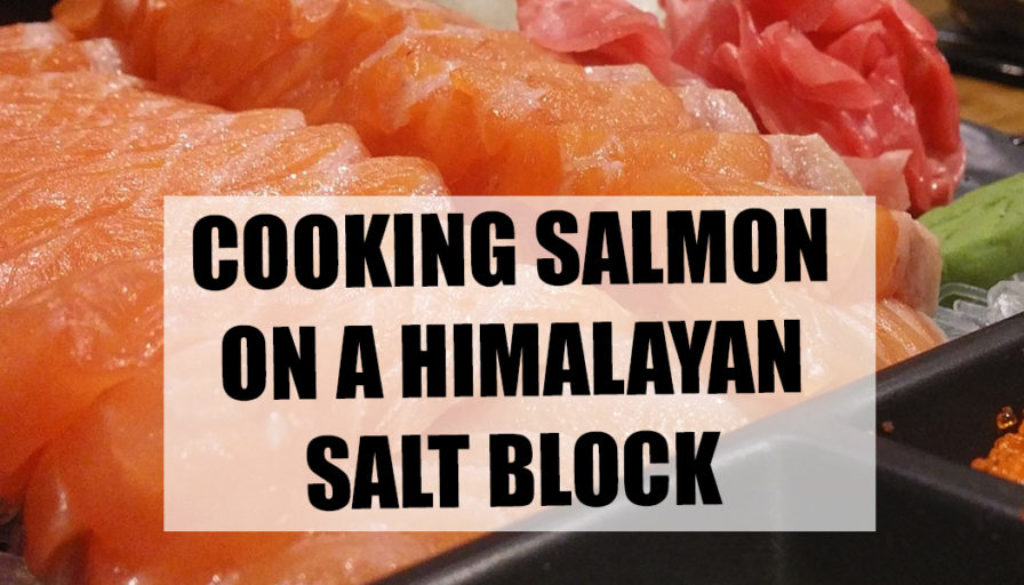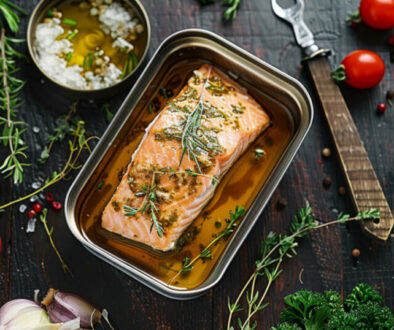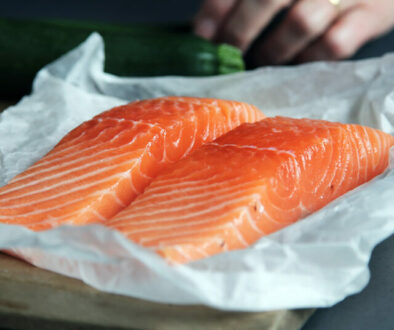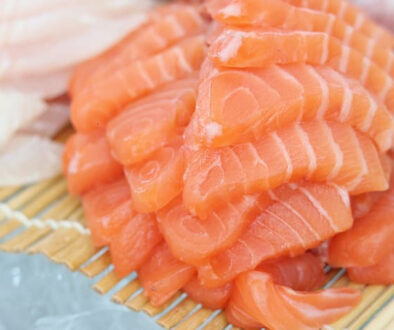Cooking Salmon on a Salt Block
As cool ways to cook salmon go, cooking salmon on a salt block is right up there. If you are trying to impress a date or the inlaws, walking out with a perfectly prepared slab of salmon on a block of salt is completely impressive.
Beyond being a fun way to cook and a cool way to present your salmon, cooking on a salt block adds a unique flavor to your salmon that is hard to replicate.
What are cooking salt blocks?
Himalayan salt blocks are exactly what they sound like. These are blocks of very ancient salt deposits that are mined in the Himalayan mountains and cut into natural slabs.
Himalayan salt blocks are similar to the table salt in your shaker, but contain a different balance of trace minerals such as potassium, iron, calcium, magnesium and sulfur. These differences make it have a distinct flavor from basic table salt or even modern sea salt. These additional minerals are also what gives the slabs their distinctive pink hues.
Heating your salt block
Because your salt block is a crystal, big changes in temperature can cause them to shatter or explode. The key to heating up a salt slab is to make sure that it is completely dry and then very slowly heating it up. A long slow warming process gives the crystal time to normalize throughout and not build up stress.
Heating your salt block on the grill
- Place your slab on a cold grill grate
- If using a charcoal grill, stack the coals on one side and heat the block using indirect heat only
- On a gas grill, start very low, increasing the temperature every 15 minutes
Heating your salt block on a gas stove
- Place your salt block on the stove-top.
- Set the heat to low and let the block heat at that temperature for 15 minutes.
- Switch the heat to medium and let the block heat for another 15 minutes.
- Turn the heat to high and let the block heat for another 15 minutes.
Heating your salt block in the oven
Heating your salt block in the oven can be tricky. In fact most people would not suggest doing it as the thermal shock can make the block explode, making a mess and possibly damaging your oven. If you want to do it this way though, here is the suggested heating protocol.
- Place your salt block in a cold oven
- Heat your to 250 degrees then remove the block
- Let the block rest for 30 minutes
- Return your salt block to the oven
- Raise the temperature to 400-450 degrees
Your goal with all of these methods is to get the temperature of your salt block to be around 400 to 500 degrees in temperature. The easiest way to measure this is with an infrared thermometer, which is by the way an essential kitchen tool in my opinion. If you don’t have one handy, just sprinkle a few drops of water on the block. If the water drops immediately sizzles and evaporates, you’re ready to start cooking.
Cooking salmon on a salt block video
Cooking Salmon on a salt block
Cooking salmon fillets on a salt block is about as easy as it can get. You neither want nor need to get fancy with this.
- Preheat your salt block as directed above
- Very lightly oil your salmon fillets and season (omitting any salt)
- Place your salmon on the block skin side down
- Cook for 4-8 minutes depending on thickness
- Using a metal fish turner, flip and cook ~ 4 minutes more
- Your salmon salmon is done when the juices run clear and it flakes easily
- Let your salmon rest for a few minutes before serving
- Avoid overcooking your salmon. Dry salmon is not a great dish
Cleaning your salt block
The key to cleaning a cooking salt block is to use as little water as possible. Not only will water literally dissolve the surface, but moisture in the block can make it crack. What you are really trying achieve is removal of big chunks of material from the surface, not sterilization.
After letting your salt block cool completely, scrape/scrub any stuck on food from the surface. A soft brush or green scrubby is perfect for this. If you must use water, use a damp sponge to wipe the surface. NEVER submerge your salt block in water.
If you are worried about bacteria, remember that this is a block of salt and that in and of itself makes it anti-microbial. On top of that, you will be heating it to over 400 degrees before putting any food on it again.
Choosing salt block
If you start shopping for a Himalayan salt block, you will likely find it a bit intimidating. Poking around on Amazon for example, you will find a wide range of sizes and thicknesses.
What you need to decide first is how big of a block you need. Will you be cooking for two people at once or four? A standard 10-12″ by 6-8″ wide block is fine for two people. If you are wanting to cook for more, I would suggest a pair of blocks.
You will want to purchase as thick of a block as possible. Many Himalayan salt blocks are only 1.5″ thick, but it look through the listings you can find some that are 2″ thick. The thicker it is, the longer it will last and less likely it is to break.
Tips on using a salt block to cook salmon
Himalayan salt block is simple to use, but you should keep a few tips in mind.
- Start with a dry salt block. Make sure that your block is completely dry before using it, as any moisture can cause it to expand and crack while heating.
- Do not salt food cooked on a salt block. This may seem like a no brainer, but we all are used to salting our food. Anything cooked on a salt block will have plenty of salt on it when it is done.
- Heat it slowly. Heating your salt block too quickly can cause it to crack. To prevent this, it’s best to increase the oven temperature by no more than 200℉ (93℃) every 15 minutes.
- Always use metal cooking tools. Salt blocks can get very hot and hold a lot of heat. This means that plastic tools can literally melt to them.
- Don’t flip you salt block. Over time cracks and imperfections will form on the cooking side of your salt block. If you change which side you are cooking on, these could become worse or even cause your block to break.
- Changes are normal. Heating can cause your salt block to develop small cracks and naturally change color over time. Try to always cook on the same side to keep cracks from worsening.
- Handle a hot block with care. A salt block can reach very high temperatures and remain hot for several hours. Regular oven mitts won’t offer sufficient protection, so you should consider using high heat-resistant gloves or a carrying rack instead.
- Don’t use fat. Butter and cooking oils aren’t necessary and can reduce the lifespan of your Himalayan salt block.
- Use as little water as possible when cleaning. Water dissolves salt, and moisture in your block is bad. It is best to clean your block with a damp sponge instead of running water. Stubborn areas can be scrubbed with a scouring pad or soft brush.
Cooking on a Himalayan salt block is a bit of a challenge, but once mastered, it is a great way to impart a flavor that you can’t get any other way.
Don’t forget that they can also be used for a wide variety of other uses, and after you cook your salmon, there will be enough heat left in your salt blocks to cook other dishes that you may be having. You should definitely experiment!



